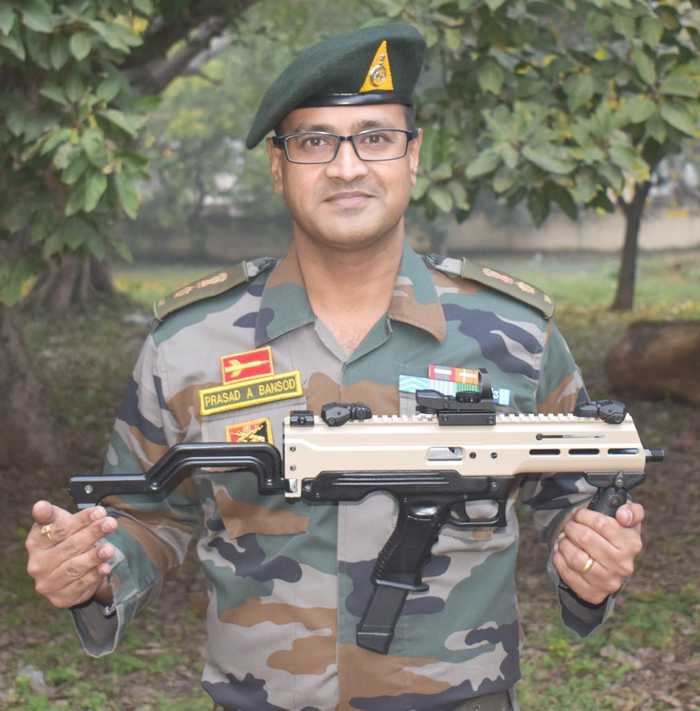Published 18:52 IST, October 1st 2024
Indian Army Inducts First Indigenous Submachine Gun Since INSAS Rifle
The Indian Army has officially inducted the ASMI submachine gun, marking a significant step in India’s journey towards self-reliance in defence manufacturing.
- Defence News
- 4 min read

New Delhi, India – The Indian Army has officially inducted the indigenous ASMI submachine gun, marking a critical milestone in the nation's quest for self-reliance in defence manufacturing. Developed by Lokesh Machines Limited in collaboration with the Defence Research and Development Organisation (DRDO), the ASMI submachine gun represents India’s determination to advance its military capabilities through indigenous innovation.
The Indian Army has placed an order for 550 ASMI submachine guns from Lokesh Machines, based in Hyderabad, at a cost of approximately ₹4.26 crores (about $550,000). This procurement is significant, as it is the first large-scale order of a domestically designed firearm for the Army since the INSAS rifle, signalling a pivotal shift in India’s defence strategy toward reducing dependency on imports.
ASMI Submachine Gun: Design and Features
The ASMI, meaning "pride" in Sanskrit, is chambered for the 9×19 mm Parabellum cartridge, a widely used standard calibre across Indian security forces. Weighing under 2.4 kg, it is 10-15% lighter than comparable submachine guns like the Uzi and MP5, enhancing its portability and ease of use in combat scenarios.

Key features of the ASMI include:
- Magazine capacity of 32 rounds.
- The firing rate of 800 rounds per minute.
- Advanced materials: Aerospace-grade aluminium for the upper receiver and carbon fibre for the lower receiver, contributing to its lightweight yet robust construction.
The weapon is intended to replace the ageing 1A Carbine, bringing a modern and efficient solution to the Army's close-quarters combat needs. Following extensive testing by elite security forces, including the National Security Guard (NSG) and Assam Rifles, the ASMI has received positive feedback for its performance in various operational environments.
Self-Reliance in Defence
The induction of the ASMI aligns with the government’s Atmanirbhar Bharat initiative, aimed at achieving self-reliance in defence manufacturing. As India seeks to strengthen its military capabilities, the introduction of indigenous weapons like the ASMI not only boosts national security but also supports the domestic defence industry.

The production of the ASMI is expected to have a ripple effect on the Indian economy by creating jobs, generating revenue, and fostering innovation within the defence sector. With a competitive price point—approximately one-third that of imported alternatives—the ASMI is also positioned for potential export, which could enhance India’s standing in global defence markets.
The Vision Behind ASMI: Lt Col Prasad Bansod’s Journey
A remarkable feature of this development is the driving force behind the ASMI’s creation—Lieutenant Colonel Prasad Bansod. Hailed as India’s own "Colonel Kalashnikov," Lt Col Bansod spearheaded the design and development of the ASMI, defying the odds with an unconventional background in the arts. His operational experience in the Indian Army and unwavering determination propelled the project forward.

Despite initial scepticism about his ability to design a world-class weapon, Lt Col Bansod’s collaboration with the Army and DRDO resulted in a successful indigenous product. His contribution to India's defence industry underscores the nation’s growing self-reliance and technological prowess.
A Strategic Boost for India’s Defence Forces
The ASMI’s compact and lightweight design makes it ideal for close-quarters combat and special operations. It is expected to serve tank and aircraft crews, drivers, heavy weapon detachments, and other personnel operating in confined environments.
The weapon’s advanced materials, including a Picatinny rail for mounting optics and accessories, and M-LOK slots for added modularity, further enhance its utility in modern combat. The ASMI offers two barrel configurations—7.2-inch and 6.5-inch—allowing flexibility for different mission requirements.

Given its chambering for the 9×19mm Parabellum cartridge, already in use by the Indian Army, the ASMI also offers logistical advantages over its predecessor, the Modern Sub Machine Carbine (MSMC), reducing ammunition supply chain complexities.
Expanding Indigenous Defence Horizons
Following its induction into the Indian Army, Lokesh Machines is eyeing the potential to supply the ASMI to other security forces, such as the Border Security Force (BSF) and Assam Rifles. This widespread adoption across various branches of India’s armed forces will contribute to a unified approach toward modernizing India’s infantry capabilities.
The ASMI submachine gun also exemplifies the transfer of technology within the Indian defence ecosystem. Its development sets the stage for future indigenous weapons systems, reducing vulnerabilities associated with foreign imports.
Updated 18:52 IST, October 1st 2024
